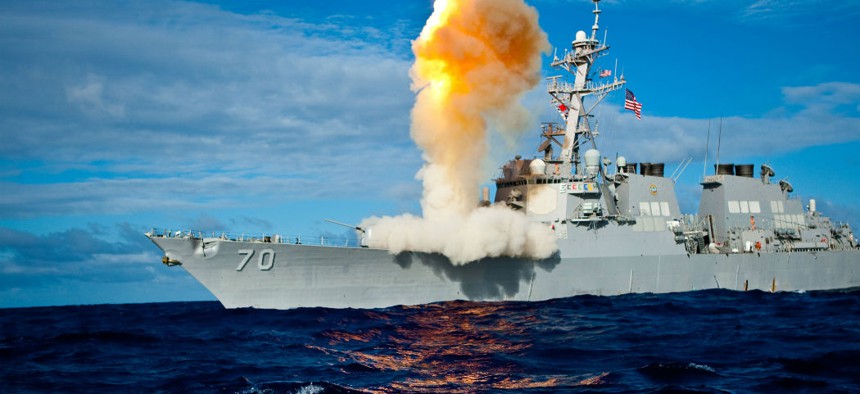CNO: Network, cyber connectivity key to future Naval superiority
IT upgrades and next generation platforms will help grow the Navy’s network use so that it can maintain maritime superiority.
The Navy is modernizing shipboard IT systems and networks to provide real time, combat-relevant information across the fleet, according to Chief of Naval Operations Adm. John Richardson.
Speaking at the 2017 Future Naval Force S&T Expo last week, Richardson emphasized that combat networks were key to giving the Navy an asymmetrical advantage.
“When you start to network all of our platforms like this you depart from the linear, and you start to see Naval power increase in non-linear ways,” he said.
A key part of network integration is information technology (IT) systems and software. On the same day as Adm. Richardson’s presentation, the Navy brought in three information technology firms to support its Enterprise Information System Program Executive Office (PEO EIS).
PEO EIS network’s functions include managing software licensing for the Navy, with a focus on investment in cyber security. It also is in charge of the software and systems that allow the Navy to manage material, manpower, and resources, according to PEO EIS. In this capacity the office is key to acquiring and ensuring that the fleet network is built.
The firms, eScience & Technology Solutions Inc., IDEAMATICS Inc., and Rite-Solutions Inc., will apply commercial-off-the-shelf IT and software solutions within the architecture of the enterprise information system. eScience & Technology Solutions (eSTS), for example, has already worked with the Navy on intelligence and reconnaissance data and software systems, such as the Identification Friend or Foe system, according to eSTS.
“The information world that we talk about, most of that traffic flows on cables that reside on the ocean floor, so the maritime is right in the middle of the information technology world,” said Adm. Richardson. “We talk about a cloud…but all that information is down on the ocean floor, we should be talking about a sea of data, not a cloud.”
Another way in which Adm. Richardson’s vision of a networked Navy is being made reality is through plans for the next generation Guided Missile Frigate, or the FFG(X). According to the Navy’s newly released Request for Information, the FFG(X) is intended as a platform for unmanned systems and advanced sensor technology with a specific focus on ensuring the unmanned systems can function in contested environments and disperse data throughout the fleet via network links.
“The FFG(X) will be capable of establishing a local sensor network using passive onboard sensors, embarked aircraft and…unmanned vehicles to gather information and then act as a gateway to the fleet tactical grid using resilient communications systems and networks,” according to an Office of Naval Research (ONR) spokesperson.
A networked Navy would mean that data gathered by one ship’s unmanned aerial vehicle, reconnaissance jet, or sensor systems would be instantaneously available to all ships belonging to the network, according to statements by the ONR. Naval commanders’ situational awareness would increase as well as their ability to make rapid, well-informed navigation and target acquisition decisions.
“We are moving to an era where it’s not about precision, but about decisions. How do you sort through that, sift out what is normal, what is abnormal, and make a decision that will lead to action?” said Adm. Richardson. “It’s the speed of decisions and the sense of urgency that … empower our people to make the decisions…as we move to try to get our product to the field at the pace that technology is being created.”
Network-enabled interconnectivity makes interoperability between naval platforms possible, and that is what will give the Navy the ultimate advantage, he said. The work on the Navy’s information network systems is scheduled to occur over the next five years, while the Navy aims to begin initial work on the FFG(X) around 2020.




